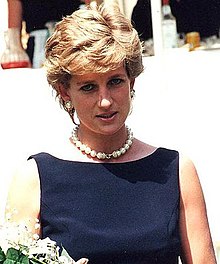Diana; Princess of Wales: A woman and a Dreamer of courage who spoke out against Land mines; even if she could pretend like everybody else....
Comment:
Why wasnt i surprised when i heard the announcement on the radio? it was as if i was expecting this kind of news about her. She had over reached the limits of being a modern woman and a female Royalty and she had reached the luxurious point of being (and acting) totaly herself .
It was the 31st of August of 97 and i think a lot of people who liked her thought that their own friend had passed away , she felt like some one we knew well, as if she had been part of our every day life. Some one who cared. A person with normal feelings and passions and a friend who came right out of the future , very much ahead of the ordinary people who were just trying to survive. She won the war of the normal people who she represented , who want to live in peace , in a world and an environment which is still intact . (normal people who dont want to go and live in Space stations or on Mars , and who can afford and want to live on this earth) ....
Diana, Princess of Wales
Why wasnt i surprised when i heard the announcement on the radio? it was as if i was expecting this kind of news about her. She had over reached the limits of being a modern woman and a female Royalty and she had reached the luxurious point of being (and acting) totaly herself .
It was the 31st of August of 97 and i think a lot of people who liked her thought that their own friend had passed away , she felt like some one we knew well, as if she had been part of our every day life. Some one who cared. A person with normal feelings and passions and a friend who came right out of the future , very much ahead of the ordinary people who were just trying to survive. She won the war of the normal people who she represented , who want to live in peace , in a world and an environment which is still intact . (normal people who dont want to go and live in Space stations or on Mars , and who can afford and want to live on this earth) ....
Diana, Princess of Wales
| Diana | |
|---|---|
| Princess of Wales (more) | |

Diana, Princess of Wales, in Moscow, 1995
| |
| Born | Diana Frances Spencer 1 July 1961 Park House, Sandringham, Norfolk, England |
| Died | 31 August 1997 (aged 36) Pitié-Salpêtrière Hospital, Paris, France |
| Burial | 6 September 1997 Lake Round Oval, Althorp, Northamptonshire, England |
| Spouse | |
| Issue | |
| House | |
| Father | John Spencer, 8th Earl Spencer |
| Mother | Frances Shand Kydd |
| Signature |  |
Diana was born into the Spencer family, a family of British nobility with royal ancestry, and she was the youngest daughter of John Spencer, Viscount Althorp, and Frances Roche. She grew up in Park House, situated on the Sandringham estate, and was educated in England and Switzerland. In 1975—after her father inherited the title of Earl Spencer—she became known as Lady Diana Spencer. She came to prominence in February 1981 when her engagement to Prince Charles was announced to the world.
Diana's wedding to the Prince of Wales took place at St Paul's Cathedral on 29 July 1981 and reached a global television audience of over 750 million people. During her marriage, Diana was Princess of Wales, Duchess of Cornwall, Duchess of Rothesay, and Countess of Chester. The marriage produced two sons, the princes William and Harry, who were then respectively second and third in the line of succession to the British throne. As Princess of Wales, Diana undertook royal duties on behalf of the Queen and represented her at functions overseas. She was celebrated for her charity work and for her support of the International Campaign to Ban Landmines. Diana was involved with dozens of charities including London's Great Ormond Street Hospital for children, of which she was president from 1989. She also raised awareness and advocated ways to help people affected with HIV/AIDS, cancer, and mental illness.
Diana remained the object of worldwide media scrutiny during and after her marriage, which ended in divorce on 28 August 1996 following well-publicised extramarital affairs by both parties. Media attention and public mourning were extensive after her death in a car crash in a Paris tunnel on 31 August 1997 and subsequent televised funeral.
Comments
Post a Comment